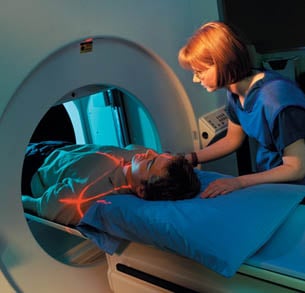 A CT scan can be an important diagnostic tool, but like most medical procedures, it carries a degree of risk. It’s important to understand how the procedure works and consider the risks and benefits before deciding with your doctor whether it’s right for you.
A CT scan can be an important diagnostic tool, but like most medical procedures, it carries a degree of risk. It’s important to understand how the procedure works and consider the risks and benefits before deciding with your doctor whether it’s right for you.
Detailed Information from a Non-Invasive Procedure
A CT scan provides a detailed look inside the body, which can prove invaluable for diagnosing many conditions. CT stands for “computed tomography” (sometimes called "computed axial tomography" or ‘CAT’ scan). It uses specialized X-ray equipment to produce cross-sectional image “slices” of the body, which are combined into a three-dimensional image to reveal the body's hidden insides. [1] The X-ray source and a detector assembly within the system rotate around the patient repeatedly while the patient is in the CT unit. A single rotation typically takes a second or less, while the X-ray source produces a narrow, fan-shaped beam of electromagnetic energy (X-rays) that passes through a section of the patient's body. These are registered by detectors, in rows opposite the X-ray source, and many different images are created. The image data is sent to a computer to reconstruct all of the individual images into one or multiple detailed depictions of the internal organs and tissues. Modern scanners can register hundreds of different angles of images, providing a three-dimensional (3D) scan result almost as detailed as looking into the body surgically. Unlike surgery, however, a CT scan is a non-invasive outpatient procedure, which allows medical providers to evaluate and diagnose conditions and treatment progress with a high degree of accuracy at a dramatically lower risk.[2] The National Cancer Institute favorably notes that “CT can be a life-saving tool for diagnosing illness and injury in both children and adults.”[3]
Risk Related to Radiation Dose
Any exposure to X-rays, however, comes with some risk related to the ionizing radiation that they produce -- a powerful form of energy that is potentially harmful to DNA.[4] Ionizing radiation may increase a person’s risk of developing cancer. Because children are particularly sensitive to its effects, extra precautions must be taken when performing pediatric CT scans.[5] For more detailed information to help you understand and evaluate the effects of radiation from CT scans, read our blog post, "Wise and Safe Diagnostic Imaging: Understanding Radiation Dose."
Understand, however, that even a relatively high-dose scan such as an abdominal CT is associated with only a slight increase in cancer risk. According to Scientific American, “a 2006 report from the National Research Council has estimated that exposure to 10 mSv—the approximate dose from a CT scan of the abdomen—increases the lifetime risk of developing any cancer by 0.1 percent. Using the same basic information, the U.S. Food and Drug Administration concluded that 10 mSv increases the risk of a fatal cancer by 0.05 percent. Any one person in the U.S. has [approximately] a 20 percent chance of dying from cancer. Therefore, a single [abdominal] CT scan increases the average patient's risk of developing a fatal tumor from 20 to 20.05 percent.” [6] The information obtainable through such a scan, on the other hand, may enable practitioners to diagnose and effectively treat a much riskier and more immediate problem.
Risk Associated with Contrast Material
In addition to concerns about radiation exposure, some patients worry about adverse reactions or allergies to the contrast material or dye sometimes used to enhance the CT scan image. This material, depending on the type of exam and contrast material used, can be injected intravenously, given via enema, or taken orally as a chalky liquid or tablet. If contrast material is used, a patient must usually abstain from food and drink for 4-6 hours prior to the scan. The contrast material can be incompatible with some medications, including the diabetes medication metformin (Glucophage). Injected contrast dye can cause a mild burning feeling or warm flush and a metallic taste, which usually dissipate quickly and do not have lasting effects. The most common contrast materials contain iodine, gadolinium, or barium sulfate. Patients who have an allergy to iodine may experience nausea, vomiting, sneezing, itching, or hives. Your primary care provider may prescribe antihistamines (like Benadryl) or steroids if these side effects occur. Patients with compromised kidney function may be advised to consume extra fluids to help flush the additional iodine from the kidneys following scans using this type of dye. Patients with a history of breathing disorders, including asthma or allergies, or those with cystic fibrosis or intestinal problems are more likely to experience adverse reactions or allergies to barium-containing materials. These side effects can include stomach upset, cramps, diarrhea, nausea, and constipation. More serious reactions to contrast materials are very rare.[7] Please inform your technologist of any allergies or medical conditions.
Minimizing Risk
The FDA advises that “in children and adults, the risk from a medically necessary imaging exam is quite small when compared to the benefit of accurate diagnosis or intervention” and recommends limiting scans to the most targeted and specific areas possible to minimize radiation dose.[8] Federal and state regulations require all facilities and providers of CT scans to use approved safety protocol and training and require practitioners to follow guidelines to ensure CT scan technology is used as sparingly and as safely as possible. At Iowa Radiology, we have invested in radiation dose reducing software which can reduce the dose by up to 60%.
At Iowa Radiology, we work with referring providers to minimize each patient’s risk and side effects from this valuable diagnostic procedure. We’ve worked to ensure that the most advanced radiation-reduction technology, the most comprehensive training, and the best care practices are being implemented for both adults and children. To learn more, or if you ever have any questions or concerns about the CT scan process, please contact us. Our clinics are conveniently located in Clive, Lakeview, Ankeny, and downtown Des Moines. CT scans can be performed at our Clive and downtown Des Moines locations.
The information contained in the Iowa Radiology website is presented as public service information only. It is not intended to be nor is it a substitute for professional medical advice. You should always seek the advice of your physician or other qualified healthcare provider if you think you may have a medical problem before starting any new treatment, or if you have any questions regarding your medical condition.
Iowa Radiology occasionally supplies links to other web sites as a service to its readers and is not in any way responsible for information provided by other organizations.
[1] “Computed Tomography (CT).” U.S. Food & Drug Administration (FDA). U.S. Department of Health and Human Services. Web. 22 Oct. 2014.
[2] Id.
[3] “Fact Sheet: Computed Tomography (CT) Scans and Cancer.” National Cancer Institute. National Institutes of Health. Web. 23 Oct. 2014.
[4] “Computed Tomography (CT).” U.S. Food & Drug Administration (FDA). U.S. Department of Health and Human Services. Web. 22 Oct. 2014.
[5] Id.
[6] “How Much Do CT Scans Increase the Risk of Cancer?” Scientific American. Macmillan Publishers. Web. 24 Oct. 2014.
[7] “Patient Safety: Contrast Materials.” RadiologyInfo.org. Radiological Society of North America and American College of Radiology. Web. 24 Oct. 2014.
[8] “Computed Tomography (CT).” U.S. Food & Drug Administration (FDA. U.S. Department of Health and Human Services. Web. 22 Oct. 2014.


